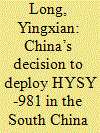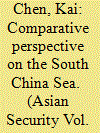| Srl | Item |
| 1 |
ID:
148393


|
|
|
|
|
| Summary/Abstract |
This article sheds light on developing a hybrid analytical construct by combining Foreign Policy Analysis (FPA) theory and modifications tailored to the case of China. It employs the bureaucratic politics model to China’s decision making during the China–Vietnam standoff in 2014 and adjusts the traditional model with intervening variable – the party ranking system and Democratic Centralism doctrine. I argue that the bargaining game among different actors who have diverse agendas led to the shift in China’s strategy. It would concurrently advance FPA studies while developing a future avenue for research on foreign policy formulation of China.
|
|
|
|
|
|
|
|
|
|
|
|
|
|
|
|
| 2 |
ID:
148395


|
|
|
|
|
| Summary/Abstract |
The Asia-Pacific region, even the world, is increasingly focusing on the South China Sea, which is not only one of the most important waterways in the world but also a hot spot of competing claims to territorial sovereignty. The disputes in this region are not new. They can be categorized into two groups: the first concerning territorial sovereignty over islands or reefs, and the second the overlapping exclusive economic zones and continental shelf claims. Historically, the claimants follow the 1982 United Nations Convention on the Law of the Sea (UNCLOS).
|
|
|
|
|
|
|
|
|
|
|
|
|
|
|
|
| 3 |
ID:
148394


|
|
|
|
|
| Summary/Abstract |
This article argues that the Tibetan self-immolations constitute a form of counter-securitization to China’s securitization of the 2008 Tibetan uprising. Theoretically, it argues that securitization theory (1) is too focused on the intra-unit interaction between securitizing elites and audiences, (2) leaves the inter-unit dynamics underdeveloped, and (3) fails to recognize the securitized “other” as an audience. This article theorizes the linkage between unit-level and inter-unit processes by exploiting three concepts: inter-discursivity, identity, and emergency measures. Contrary to existing theories, it shows that even unsuccessful securitizing moves can set off counter-securitizations thanks to audience overlap and inter-discursivity. The Sino-Tibetan interactions around the Tibetan self-immolations uphold these theoretical positions.
|
|
|
|
|
|
|
|
|
|
|
|
|
|
|
|
| 4 |
ID:
148392


|
|
|
|
|
| Summary/Abstract |
This article argues that the relationship between the United States and Japan can be understood as a security community. According to Karl Deutsch, collective identity is a defining feature of a security community. Hence, this study employs the case of the Persian Gulf War of 1990–1991 to detect the existence of a collective identity between the United States and Japan. Employing Bruce Cronin’s approach, we examine how the United States and Japan interacted with each other in their discourse and behavior during the period of the war from August 1990 to April 1991. This article presents evidence of their shared collective identity in verbal exchanges and in a series of mutual behaviors regarding Japan’s role in an anti-Saddam coalition.
|
|
|
|
|
|
|
|
|
|
|
|
|
|
|
|